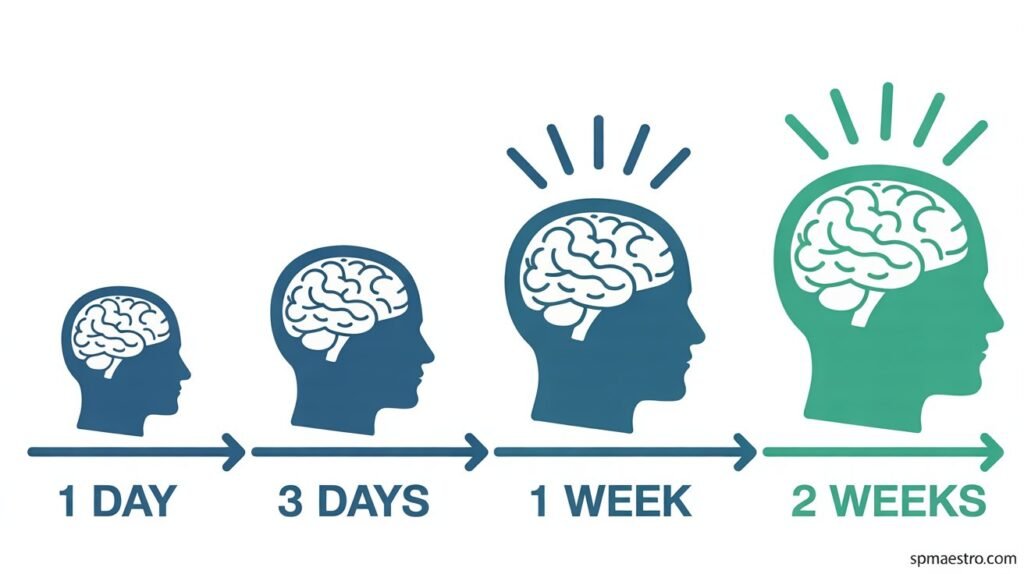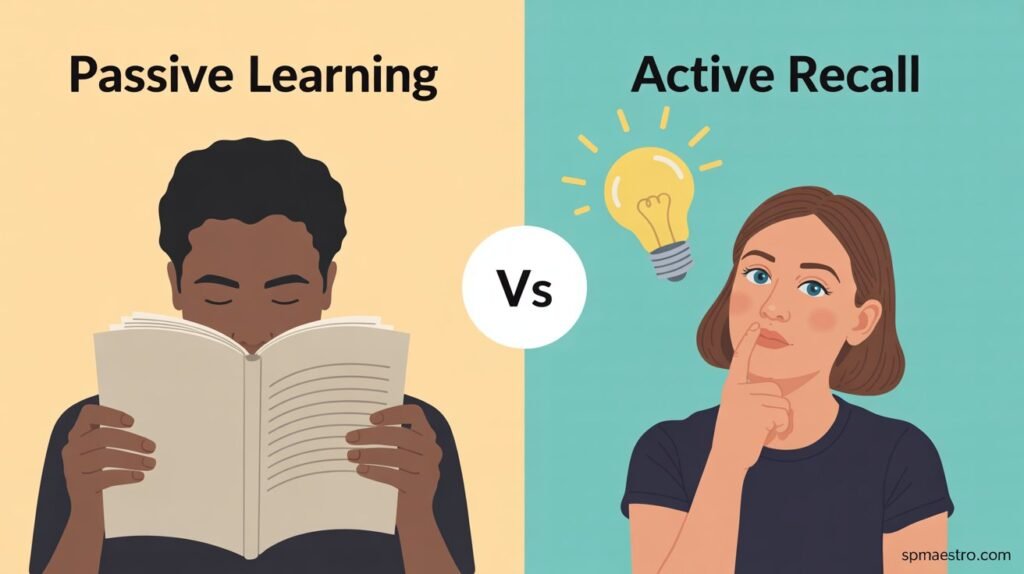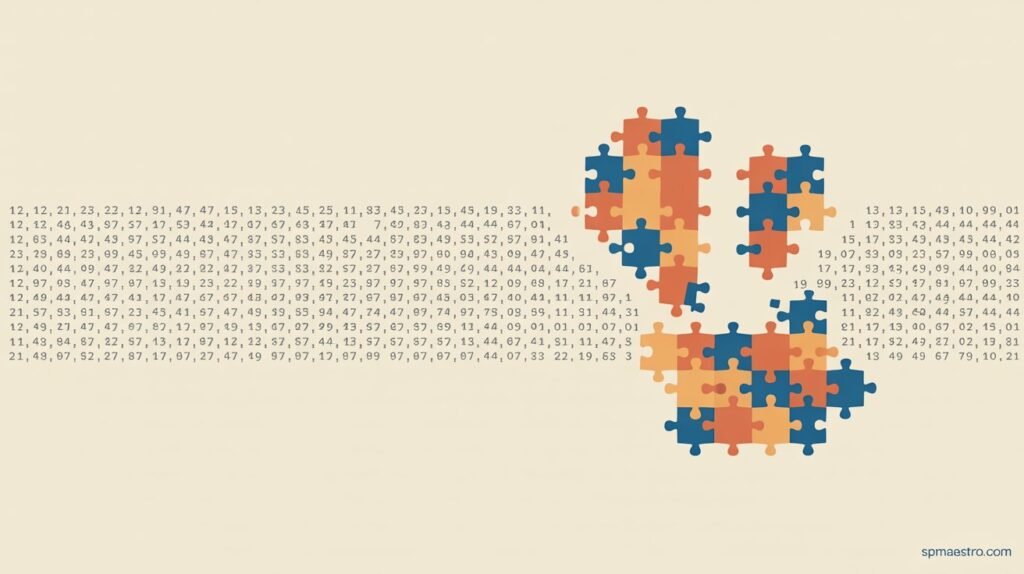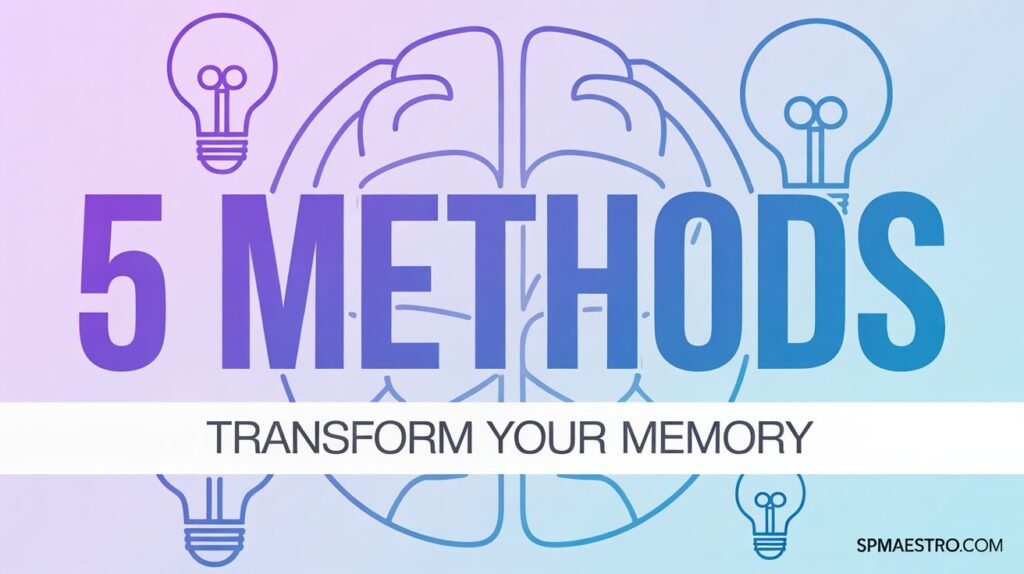Why Traditional Learning Fails You
You’ve been there. You spend hours cramming for an exam, only to forget everything a week later. You attend a networking event, meet ten people, and can’t recall a single name by the time you reach your car.
The problem isn’t your brain. It’s your method.
Your brain is a remarkable machine, but it needs the right techniques to perform at its peak. The good news? Science has unlocked the secrets to exceptional memory, and these memory techniques are easier than you think.
1. Spaced Repetition: The Memory Technique That Defeats Forgetting

Remember when you could sing every lyric to your favorite childhood song? That’s spaced repetition in action, and it’s one of the most powerful memory techniques you can master.
How Spaced Repetition Works
Instead of cramming all your information into one marathon study session, you spread it out over time. Think of it like watering a plant. You don’t dump a bucket of water once and call it done. You give it small amounts regularly.
The magic happens in the intervals. Review your material after one day, then three days, then a week, then two weeks. Each time you recall information, you strengthen the neural pathways in your brain.
Apply It Today
Learning a new language? Review your vocabulary daily for a week, then every other day, then once weekly. Those words won’t just stick—they’ll become permanent residents in your brain.
2. Active Recall: The Memory Technique That Builds Mental Muscle

Your brain is like a muscle. The more you flex it, the stronger it becomes. Active recall is the ultimate workout for your memory.
Stop Passive Reading, Start Active Thinking
Here’s where most people fail: they reread their notes a dozen times and wonder why nothing sticks. Passive reading creates an illusion of learning. Active recall forces your brain to do the heavy lifting.
Close your textbook. Put away your notes. Now try to explain the concept out loud. Struggling? Good. That struggle is your brain building new neural pathways.
Research shows that explaining concepts without reference materials strengthens memory pathways more effectively than any other memory technique.
Make It Practical
After reading this article, close your eyes and recall the five memory techniques. Can’t remember them all? That’s your brain telling you where to focus your next review.
3. Memory Palace: The Ancient Memory Technique That Still Dominates

Your brain has a superpower: spatial memory. You can remember your childhood home’s layout in vivid detail, but you can’t remember last week’s grocery list. The Memory Palace technique harnesses this natural ability.
Build Your Mental Palace
Create a palace in your mind—it can be your actual home, your office, or an imaginary location. The key is familiarity. Now, place each piece of information you want to remember in different rooms.
Preparing a presentation? Put your opening statement in the living room, your first key point in the kitchen, your second in the bedroom. When it’s showtime, mentally “walk” through your palace and retrieve each point.
Memory champions use this technique to memorize thousands of digits. You can use it to ace your next presentation.
Why This Memory Technique Works
Your brain evolved to remember locations for survival. We needed to remember where food was, where predators lurked, and how to get home. This ancient wiring makes the Memory Palace one of the most reliable memory techniques available.
4. Chunking: The Memory Technique That Makes Complex Simple

Ever wonder why phone numbers are grouped in chunks? Because your brain can’t handle long strings of random information, but it excels at processing smaller groups.
Break It Down to Remember Better
Instead of memorizing a 12-digit number as one long string, break it into four chunks of three digits. Like organizing a messy desk into labeled drawers, chunking makes information digestible.
This memory technique works for everything: credit card numbers, historical dates, presentation points, even complex concepts. Group related information together, and your brain will thank you.
The Playlist Method
Think of chunking like creating a playlist. You don’t remember 100 individual songs—you remember them grouped by genre, mood, or artist. Apply this same principle to whatever you’re learning.
5. Visualization: The Memory Technique That Creates Lasting Impressions

A picture isn’t just worth a thousand words—it’s worth a thousand memories.
Make It Vivid, Make It Stick
Your brain processes images 60,000 times faster than text. When you transform abstract information into vivid mental pictures, you’re speaking your brain’s native language.
Need to remember someone’s name? Create a visual association. Meeting Sarah? Imagine her wearing a princess tiara (Sarah… as in princess). Meeting Mike? Picture him holding a microphone.
The more ridiculous and exaggerated your visualizations, the better they stick. Your brain loves novelty and emotion, so don’t hold back.
From Theory to Action
Don’t just read about visualization—practice it now. For each memory technique in this article, create a mental image. Spaced repetition could be seeds growing with watering cans appearing at intervals. Active recall could be a brain lifting weights.
Combining Memory Techniques for Maximum Impact
Here’s the secret the memory champions won’t tell you: the real power comes from combining these memory techniques.
Use spaced repetition to schedule your reviews. During those reviews, practice active recall. Store complex information using chunking, place it in your Memory Palace, and use visualization to make it vivid.
This combination creates a fortress of memory. Information doesn’t just stick—it becomes part of you.
Your 30-Day Memory Transformation Challenge
Ready to transform your memory? Here’s your action plan:
Week 1: Master spaced repetition. Choose one thing you’re learning and create a review schedule.
Week 2: Add active recall. After each learning session, close your materials and explain concepts aloud.
Week 3: Build your first Memory Palace. Start small—use your home to remember a presentation or shopping list.
Week 4: Integrate all techniques. Chunk your information, visualize it, place it in your Memory Palace, and review using spaced repetition with active recall.
By day 30, you’ll notice the difference. Information that once slipped away will stay locked in your mind.
The Science Behind These Memory Techniques
These aren’t just tricks—they’re backed by decades of neuroscience research. Studies show that spaced repetition can improve long-term retention by up to 200%. Active recall has been proven more effective than passive review in over 100 research studies.
The Memory Palace technique dates back to ancient Greece, used by orators who gave hours-long speeches without notes. If it worked for them, it’ll work for you.
Common Mistakes to Avoid
Even the best memory techniques fail when misapplied. Here’s what to avoid:
Mistake 1: Reviewing too frequently. Spaced repetition needs gaps. Don’t review everything daily.
Mistake 2: Passive recognition instead of active recall. Highlighting and rereading feel productive but don’t build strong memories.
Mistake 3: Creating boring visualizations. Make them weird, funny, or emotional. Bland images don’t stick.
Mistake 4: Trying to memorize everything. Focus on concepts and connections, not raw facts.
Technology Tools That Enhance Memory Techniques
While these memory techniques work with just your brain, technology can amplify them:
- Anki: Spaced repetition flashcard app
- RemNote: Combines note-taking with spaced repetition
- Memory Palace Builder: Digital tools for creating memory palaces
- Notion: Great for organizing chunked information
Remember: tools enhance technique, but they don’t replace it. Master the fundamentals first.
Transform Your Life with Better Memory
Imagine walking into any meeting and recalling everyone’s name. Picture yourself learning a new language in months instead of years. Envision acing exams without last-minute cramming.
These memory techniques make all this possible. Not someday. Not eventually. Starting today.
Your brain is capable of extraordinary things. These memory techniques simply unlock what’s already there. The question isn’t whether you can improve your memory—it’s whether you’re ready to start.
Close this article. Take a deep breath. Now recall the five memory techniques without scrolling up. That’s active recall in action. You’ve already begun your journey.
Frequently Asked Questions (Schema FAQs)
A: Most people notice improvement within 2-3 weeks of consistent practice. However, spaced repetition and active recall can show benefits within the first week.
A: Anyone can master these memory techniques. Memory champions aren't born with special brains—they use these exact methods we've covered.
A: Active recall combined with spaced repetition shows the strongest results in research. However, combining multiple techniques creates the best outcomes.
A: Start with 15-20 minutes per day. As the techniques become natural, you'll integrate them seamlessly into your existing learning routine.
A: Yes, many people with ADHD find these techniques especially helpful. However, consult with a healthcare professional for personalized strategies.
A: Absolutely not. Research shows that memory techniques work at any age. Your brain maintains neuroplasticity throughout life.
Other interesting content you may like
-
His Holiness Beloved SP Maestro Invited as Special Guest for Hanuman Chalisa Meditation in London
-
1600+ Days of Continuous Yagnas and Counting: An Ongoing Mission for Global Harmony
-
Journey of SP Maestro
-
Free Medical Camp Serves 150 Residents in Ramalakshmana Pally
-
What Are Mudras? 7 Sacred Hand Positions That Powerfully Transform Your Well-Being
-
7 Rules for Charisma: Proven Secrets to Become Magnetic in Any Room
-
Healing the Inner Child: 4 Powerful Trauma Types & Affirmations to Transform Your Life
-
Discipline Mastery: 6 Game-Changing Rules for Unstoppable Success
-
Memory Techniques That Will Transform Your Learning: 5 Proven Methods to Boost Retention by 300%
-
Stress Effects on Body: 8 Shocking Ways Stress Destroys Your Health
Our other websites for more spiritual insight
Explore Inspiring Spiritual Websites
Aumaujaya.org
A spiritual website filled with inspiring content to help you deepen your understanding of mindfulness and living in the present. Explore their teachings to enrich your journey toward inner peace.
Visit Website →Auysa.org
A platform dedicated to motivating and uplifting the spirit of youth. If you’re looking for ways to inspire younger generations to embrace the present, this is a fantastic resource.
Visit Website →Shreeprabhu.org
A spiritual website with inspiring content centered around the idea of “Universal Oneness.” Their teachings align beautifully with the art of being present and finding happiness in every moment.
Visit Website →


